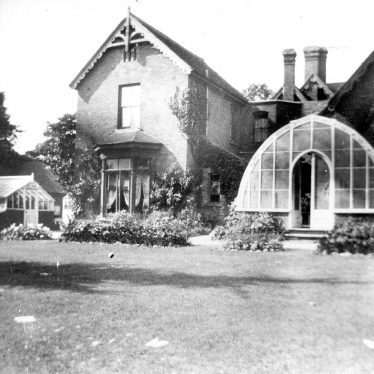The World War 1 service records, that are now available to view on-line, give varying degrees of detail. They sometimes contain information about the serviceman’s relatives - parents, wives and children. When checking if George Edwin Robbins, of Pitchers Hill, Wickhamford, served in the War, a separate search was made under his wife’s name to see if that produced any information. The pair lived at ‘16 Pitchers Hill’ at the time the 1924 Electoral Register was drawn up (now no. 46 Pitchers Hill).

She was Annie Lily Robbins and, surprisingly, a record was found, in the British Red Cross archives, for her service in the Voluntary Aid Detachment (VAD). She joined in December 1916 when living at The Cottage, Tanworth-in-Arden, Warwickshire. She worked at the VAD Hospital at nearby Henley-in-Arden; it also had an extension at Wootton Hall. She was not a nurse, but employed in a secretarial role, until she left on 5th April 1919.
The information on her time in the VAD revealed that, on starting in 1916, she was paid 12/6 per week. This had increased to £1.0.0d per week by the time she left in 1919. The document also recorded that during the two years, four months or so, of her employment, she worked a total of 3,474 hours.
Annie Farley was a daughter of John and Fanny Farley. He was a general labourer, living in Sedgeberrow in 1901 and he had seven children living at home, aged from 4 to 20 years. Annie had been born on 19th September 1893. At the 1911 census, she was still living with her family in Sedgeberrow and, aged 17, was working in market gardening.
Annie Lily Farley married George Edwin Robbins in late 1917, in the Evesham District. He was a son of George and Mary Robbins who lived at what is now called ‘Robin Cottage’, Manor Road, Wickhamford. At the 1921 Census, Annie and George Robbins lived in Sedgeberrow and they had a 3-year-old son, George Henry. He had been born on 18th April 1918, so Annie continued working after his birth. This was probably unusual in that era, but if a family member or friend looked after her baby, she would have been able to resume work. It is possible that her husband, who was born in mid-1898, had been called up to serve at around this time. No definitive record has been found for a George Edwin Robbins, but one exists for a ‘George E. Robbins’. This is for a Private in the 2/8 Battalion, the Worcestershire Regiment (No 263112) who was awarded the Victory and British War Medals. As no 1914-15 Star was given to this man, he would have enlisted in 1916 or later. This man may or may not have been Annie’s husband, as no detailed service record survives.
The family were still at the same address in Wickhamford when the 1939 Register was drawn up at the start of World War 2. George snr was a market gardener in his own right, Annie also worked on the land and their son helped his father on his holding. Information from the National Farm Survey, which looked at the Robbins market garden land in December 1942, showed that George Edwin Robbins had 13 acres of land. He was listed as a part-time market gardener and also in the fruit and vegetable haulage business. He was growing a range of vegetables and employed one male and two female family members. The report also stated that his management of the land was not of the highest quality, due to a drink problem.
George Henry Robbins served in the Royal Engineers in the Second World War and married Gertrude Elizabeth Smith in Wickhamford on 16th August 1941.
The family continued to live in Wickhamford, George Edwin dying in 1973 and Annie Lily, in Pershore, on 23rd January 1989, aged 95. Both are buried in Wickhamford Cemetery, sadly, in separate unmarked graves, nos. 38 and 43 respectively. Their son, George Henry Robbins, died at Heathlands, Pershore, on 8th March 1993. He was buried, in Wickhamford, in another unmarked grave, no. 64.
Note: The Voluntary Aid Detachment was a voluntary unit of civilians providing nursing care for military personnel. It had been founded as early as 1909, by the British Red Cross and St John, and by 1914 had 74,00 volunteers.
Tom Locke – March 2024
